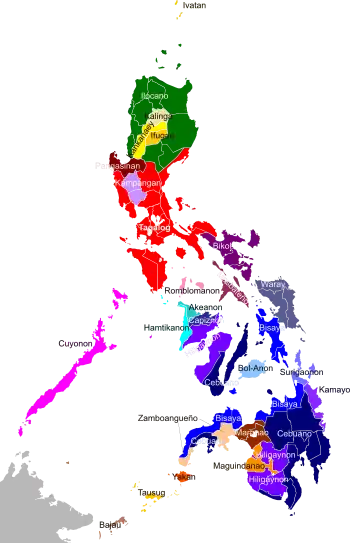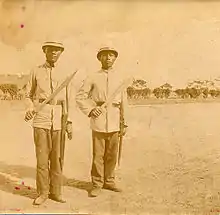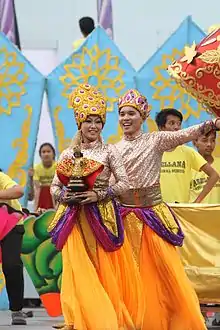Cebuano people
The Cebuano people (Cebuano: Mga Sugbuanon) are the largest subgroup of the larger ethnolingustic group Bisaya, who constitute the largest Filipino ethnolinguistic group in the country. Their primary language is the Cebuano language, an Austronesian language. They originated in the province of Cebu in the region of Central Visayas, but then later spread out to other places in the Philippines, such as Siquijor, Bohol, Negros Oriental, southwestern Leyte, western Samar, Masbate, and large parts of Mindanao. It may also refer to the ethnic group who speak the same language as their native tongue in different parts of the archipelago.
| Total population | |
|---|---|
| 9,125,637 (2010)[1] | |
| Regions with significant populations | |
(Central Visayas, Negros Oriental, Masbate, western parts of Eastern Visayas, large parts of Mindanao) Worldwide | |
| Languages | |
| Cebuano, Filipino, English | |
| Religion | |
| Predominantly Roman Catholicism. Minority others, Aglipayan, Protestantism, Islam, Buddhism, Hinduism, Taoism | |
| Related ethnic groups | |
| Other Filipinos (Boholano, Waray, other Visayans) other Austronesian peoples |

History


The earliest European record of Cebuanos was by Antonio Pigafetta of the Magellan expedition. He provided some descriptions of their customs as well as samples of the Cebuano language.[2][3] Ferdinand Magellan was killed in Cebu during the Battle of Mactan against the forces of Lapu-Lapu.[4][5]
Later early Spanish colonists referred to the Cebuanos (and other Visayans) as the pintados ("the painted ones"), due to their widespread practice of tattooing to record battle exploits.[5]
Culture and festivities
The majority of Cebuanos are Roman Catholic, with many in rural areas synchronizing Catholicism with indigenous Anitism, maintaining beliefs and rituals around saints as avatars for older diwata. A minority of Cebuanos (specifically those in Mindanao) are Muslim, or in mixed Chinese-Cebuano families, incorporate Catholic beliefs with aspects of Buddhism or Taoism.[6]
Among the island's notable festivities are the Sinulog[7] festival, which is a mixture of Christian and native cultural elements, celebrated annually every third week of January.
Indigenous Bisaya religion
Immortals
- Kaptan: the supreme god and sky god who fought against Magauayan for eons until Manaul intervened; ruler of the skyworld called Kahilwayan; controls the wind and lightning;[8] in some myths, is married to Maguyaen;[9] also referred as Bathala in one myth;[10] also referred as Abba in one chronicle[11]
- Maguayan: the god who rules of the waters as his kingdom; father of Lidagat; brother of Kaptan[12]
- Messengers of Kaptan
- Dalagan: the swiftest winged giant, armed with long spears and sharp swords[12]
- Guidala: the bravest winged giant armed with long spears and sharp swords[12]
- Sinogo: the handsomest winged giant armed with long spears and sharp swords; best loved by Kaptan but betrayed his master and was imprisoned under the sea[12]
- Maguyaen: the goddess of the winds of the sea[9]
- Magauayan: fought against Kaptan for eons until Manaul intervened[8]
- Manaul: the great bird who dropped great rocks upon the battle of Kaptan and Magauayan, creating islands[8]
- Helpers of Manaul
- Lidagat: the sea married to the wind; daughter of Maguayan[12]
- Lihangin: the wind married to the sea; son of Kaptan[12]
- Licalibutan: the rock-bodied son of Lidagat and Lihangin; inherited the control of the wind from his father; initiated the revolt against one of his grandfathers, Kaptan; killed by Kaptan's rage; his body became the earth[12]
- Liadlao: the gold-bodied son of Lidagat and Lihangin; killed by Kaptan's rage during the great revolt; his body became the sun[12]
- Libulan: the copper-bodied son of Lidagat and Lihangin; killed by Kaptan's rage during the great revolt; his body became the moon[12]
- Lisuga: the silver-bodied son of Lidagat and Lihangin; accidentally killed by Kaptan's rage during her brothers' revolt; her body fragments became the stars[12]
- Adlaw: the sun deity worshiped by the good[10]
- Bulan: the moon deity who gives light to sinners and guides them in the night[10]
- Bakunawa: the serpent deity who can coil around the world; sought to swallow the seven "Queen" moons, successfully eating the six, where the last is guarded by bamboos[10]
- Divities under Kaptan
- Makilum-sa-twan: the god of plains and valleys[9]
- Makilum-sa-bagidan: the god of fire[9]
- Makilum-sa-tubig: the god of the sea[9]
- Kasaray-sarayan-sa-silgan: the god of streams[9]
- Magdan-durunoon: the god of hidden lakes[9]
- Sarangan-sa-bagtiw: the god of storms[9]
- Suklang-malaon: the goddess of happy homes[9]
- Alunsina: the goddess of the sky[9]
- Abyang: another deity under Kaptan[9]
- Maka-ako: also called Laon; the creator of the universe[13]
- Linok: the god of earthquakes[13]
- Makabosog: a deified chieftain who provides food for the hungry[13]
- Sidapa: the goddess of death; co-ruler of the middleworld called Kamaritaan, together with Makaptan[9]
- Makaptan: the god of sickness; co-ruler of the middleworld called Kamaritaan, together with Sidapa; he is a brother of Magyan and Sumpoy[9]
- Deities under Sidapa and Makaptan
- Sappia: the goddess of mercy originating from the island of Bohol who empties the milk from her breasts onto weeds, giving the origin of white rice; when milk ran out, blood came out from her breast, giving the origin of red rice[9]
- Tan Mulong: guardian of a spirit cave where souls may be imprisoned; has a spirit dog with one mammary gland and two genitals[13]
- Pandaque: messenger of Sidapa; sacrifice is offered to the deity so that a soul can be admitted to the skyworld, Kahilwayan, from the lower world, Kasakitan; lives in Kasakitan, despite being a messenger of Sidapa, who lives in the middleworld, Kamaritaan;[9] also referred as Pandagoy[11]
- Magyan: carries the souls of the dead to the lower world, Kasakitan, on his boat called balanday; co-ruler of the lower world Kasakitan, together with Sumpoy; he is a brother of Makaptan and Sumpoy[9]
- Sumpoy: takes the souls from Magyan's balanday and carries them to a place in Kasakitan called Kanitu-nituhan; co-ruler of the lower world Kasakitan, together with Magyan; he is a brother of Magyan and Makaptan[9]
- Sisiburanen: ruler of Kanitu-nituhan, a sub-realm of the lower world, Kasakitan; acts as slaver of the souls of those who cannot and have yet go into the skyworld; feeds the souls to Simuran and Siguinarugan after the souls stay in Kanitu-nituhan for years[9]
- Kuruntang
- Other inhabitants of Kasakitan
- Gods of War
- Lalahon: the goddess of fire, volcanoes, and the harvest;[15] also referred as Laon[11]
- Santonilyo: a deity who brings rain when its image is immersed at sea;[16] deity of the white men, referring to Spanish colonizers[11]
- Gunung: a deity of volcanoes[11]
- Magbibaya: a deity similar to the god Magbabaya of the Bukidnon[11]
- Lumawig: a deity mentioned in the Aginid[11]
- Linug: a deity of earthquakes[11]
- Cacao: the goddess of Mount Lantoy who sells her products through a golden ship which can flood rivers[17]
- Mangao: husband of Cacao[17]
Mortals
- Sicabay: the first woman[12]
- Sicalac: the first man[12]
- Libo: the first child and son of Sicabay and Sicalac; was taken south after the defeat of Pandaguan; became the ancestor of a brown-skinned race[12]
- Saman: the first daughter and second child of Sicabay and Sicalac; was taken south after the defeat of Pandaguan; became the ancestor of a brown-skinned race[12]
- Pandaguan: a younger son of Sicabay and Sicalac; a clever man who invented the fish trap which caught a giant shark; father of Arion; challenged to overpower the gods, and was punished by zapping[12]
- Arion: son of Pandaguan who was taken north after the defeat of Pandaguan; became the ancestor of a white-skinned race[12]
- Son of Saman and Sicalac: was taken east after the defeat of Pandaguan; became the ancestor of a yellow-skinned race[12]
- Lapulapu: a ruler of Mactan who is valorous, strong, and noble, as well as driven and fearless especially in times of armed conflict; in one account, he is also a mangatang (pirate); bested Humabon in politics, trade, and ocean territory in most accounts, while in one account, Humabon managed to overcome Lapulapu;[11] defeated the Spanish forces including Magellan with aid from the forces of nature; a verified historical person[18]
- Humabon: a ruler of Sugbo who is cautious and highly respected, but also brave and courageous especially in times of armed conflict; a verified historical person[11]
- Sri Lumay Bataugong: the legendary founder of Sugbo who was said to have come from Sumatra[11]
- Sri Bantug: a ruler of Sugbo[11]
- Binibini Anduki: sister of Sri Lumay[11]
- Bulakna: wife of Lapulapu; in other epics, Lapulapu instead has three wives and eleven children[11]
- Sawili: son of Lapulapu and Bulakna[18]
- Zula: a ruler that Lapulapu had an enmity with due to both ruler's affection towards Bulakna[11]
- Datu Mangal: father of Lapulapu in most versions of the story and ruler of Mactan before Lapulapu;[11] in other versions, he is Lapulapu's uncle or friend and right-hand man; has supernatural powers, various amulets of whirlpools and oil, and a flying horse[18]
- Matang Mataunas: mother of Lapulapu; in another tale, the mother of Lapulapu is instead named Matang Matana;[11] also called Matang Mantaunas or Bauga[18]
- Malingin: daughter of Datu Mangal and sister of Lapulapu[18]
- Sri Mohammed: paternal grandfather of Lapulapu in one tale[11]
- Sri Lamaraw Dula: brother of Humabon[11]
- Bali-Alho: chief of Bo. Maribago; can break pestles with his bare hands; one of the Mactan chieftains loyally allied to Datu Mangal[18]
- Tindak-Bukid: chief of Bo. Marigondon; can level a mountain with a kick; one of the Mactan chieftains loyally allied to Datu Mangal[18]
- Umindig: chief of Bo. Ibo, a champion wrestler; one of the Mactan chieftains loyally allied to Datu Mangal[18]
- Sagpang-Baha: also called Sampong-Baha; can slap back an onrushing flood; one of the Mactan chieftains loyally allied to Datu Mangal[18]
- Bugto-Pasan: can snap the sturdiest vines with his hands; one of the Mactan chieftains loyally allied to Datu Mangal[18]
- Silyo: a chief who borrowed an amulet from Datu Mangal; he never returned the amulet and was caught by Datu Mangal fleeing; was turned into a stone along with his crew by Datu Mangal through a curse; before turning a stone completely, he also uttered a curse to turn Datu Mangal into stone; another tale tells that Matang Mataunas and Malingin were also turned into stone[18]
Language
The Cebuano language is spoken by more than twenty million people in the Philippines and is the most widely spoken of the Visayan languages. Most speakers of Cebuano are found in Cebu, Bohol, Siquijor, Biliran, Western and Southern Leyte, eastern Negros and most of northern, southeastern and western Mindanao.
See also

References
- "2010 Census of Population and Housing, Report No. 2A: Demographic and Housing Characteristics (Non-Sample Variables) - Philippines" (PDF). Philippine Statistics Authority. Retrieved 19 May 2020.
- Donald F. Lach (1994). Asia in the Making of Europe, Volume I: The Century of Discovery. University of Chicago Press. pp. 175, 635–638. ISBN 9780226467320.
- Sebastian Sta. Cruz Serag (1997). The Remnants of the Great Ilonggo Nation. Rex Bookstore, Inc. p. 95. ISBN 9789712321429.
- Blair, Emma Helen (August 25, 2004). The Philippine Islands. The Project Gutenberg EBook of The Philippine Islands, 1493-1803, Volume II, 1521-1569, by Emma Helen Blair. p. 126, Volume II. [EBook #13280].
- Paul A. Rodell (2002). Culture and Customs of the Philippines. Greenwood Publishing Group. p. 50. ISBN 9780313304156.
- "Culture and Lifestyle". Cebu Province official website.
- "Cebu Philippines Festivals, Fiestas and Cultural Event". eTravel Pilipinas-Discover the Wonders of Island Paradise. Archived from the original on 2015-09-11. Retrieved 2009-11-18.
- Hill, P. (1934). Philippine Short Stories. Manila: Oriental Commercial Company.
- Jocano, F. L. (1969). Philippine Mythology. Quezon City: Capitol Publishing House Inc.
- Buyser, F. (1913). Mga Sugilanong Karaan.
- Ouano-Savellon, R. (2014). Philippine Quarterly of Culture and Society Vol. 42, No. 3/4: Aginid Bayok Sa Atong Tawarik: Archaic Cebuano and Historicity in a Folk Narrative. University of San Carlos Publications.
- Miller, J. M. (1904). Philippine folklore stories. Boston, Ginn.
- Demetrio, F. R., Cordero-Fernando, G., & Zialcita, F. N. (1991). The Soul Book. Quezon City: GCF Books.
- Loarca, Miguel de. (1582) 1903. Relation of the Filipinas Islands. In Blair and Robertson, The Philippine Islands 5.
- Ongsotto, Rebecca R., Ongsotto, Renna R., Ongsotto, R. M. (2005). The Study of Philippine History. Rex Book Store, Inc.
- San Agustín, G. (1998). Conquistas de las Islas Filipinas, 1565-1615 (Spanish Edition): Bilingual ed edition. San Agustin Museum.
- Seki, K. (2001). Rethinking Maria Cacao: Legend-making in the Visayan Context. Philippine Studies Journal.
- Mojares, R. B. (1979). Lapulapu in Folk Tradition. University of San Carlos.